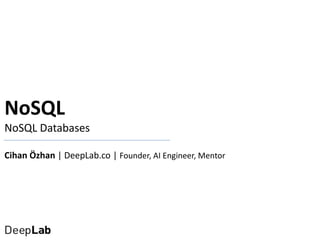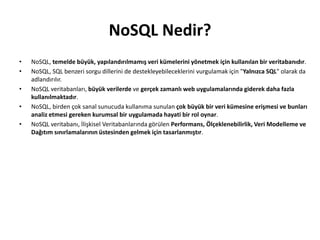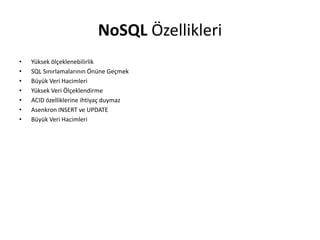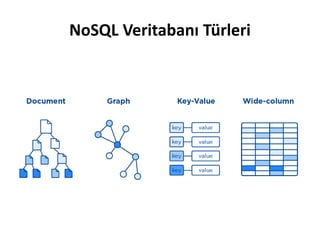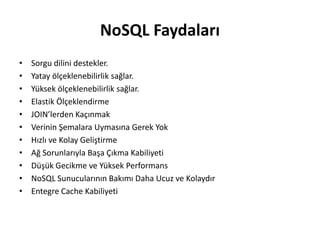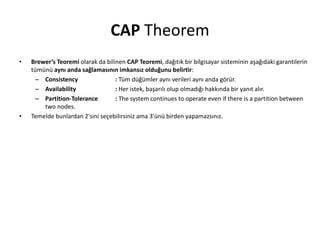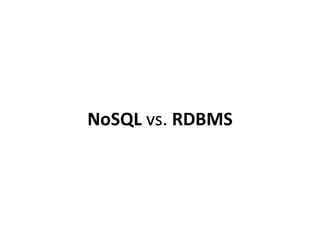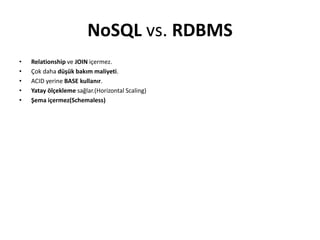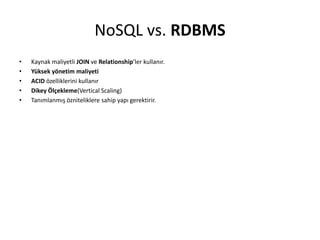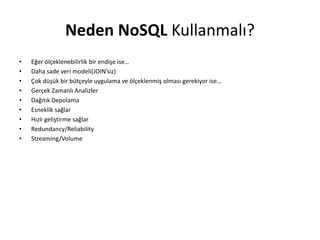MongoDB - NoSQL Overview
- 2. NoSQL NoSQL Databases Cihan ?zhan | DeepLab.co | Founder, AI Engineer, Mentor
- 3. NoSQL Nedir? ? NoSQL, temelde b©╣y©╣k, yap?land?r?lmam?? veri k©╣melerini y?netmek i?in kullan?lan bir veritaban?d?r. ? NoSQL, SQL benzeri sorgu dillerini de destekleyebileceklerini vurgulamak i?in "Yaln?zca SQL" olarak da adland?r?l?r. ? NoSQL veritabanlar?, b©╣y©╣k verilerde ve ger?ek zamanl? web uygulamalar?nda giderek daha fazla kullan?lmaktad?r. ? NoSQL, birden ?ok sanal sunucuda kullan?ma sunulan ?ok b©╣y©╣k bir veri k©╣mesine eri?mesi ve bunlar? analiz etmesi gereken kurumsal bir uygulamada hayati bir rol oynar. ? NoSQL veritaban?, ?li?kisel Veritabanlar?nda g?r©╣len Performans, ?l?eklenebilirlik, Veri Modelleme ve Da??t?m s?n?rlamalar?n?n ©╣stesinden gelmek i?in tasarlanm??t?r.
- 4. Motivasyon ? Tasar?m Sadeli?i ? Yatay ?l?eklendirme (Horizontal Scaling) ? Eri?ilebilirlik
- 5. Veritaban? Tarihi ? 1970'lerin ?li?kisel veritabanlar? icat edildi. ©C Pahal? Depolama ©C Normalle?tirilmi? Veriler ? 1980'lerin RDBMS'si ticarile?tirildi. ©C Client/Server Model ©C SQLĪ»?n standart olmas? ? 1990Ī»larda bir?eyler de?i?meye ba?lar. ©C Client/Server 3-Tier Mimari ©C ?nternet ve WebĪ»in Y©╣kseli?i ? 2000Ī»ler Web 2.0 ©C Sosyal media ve E-TicaretĪ»in y©╣kseli?i! ©C Hardware fiyatlar?ndaki s©╣rekli d©╣?©╣?.
- 6. Yeni Bir Veritaban? T©╣r©╣ ?htiyac? ? Yatay ?l?eklendirme ? H?zl? Geli?tirme ? Esnek Veri Modeli ? D©╣?©╣k Maliyet ©C D©╣?©╣k Sunucu Maliyeti ©C D©╣?©╣k Y?netim Maliyeti
- 7. NoSQL ?zellikleri ? Y©╣ksek ?l?eklenebilirlik ? SQL S?n?rlamalar?n?n ?n©╣ne Ge?mek ? B©╣y©╣k Veri Hacimleri ? Y©╣ksek Veri ?l?eklendirme ? ACID ?zelliklerine ihtiya? duymaz ? Asenkron INSERT ve UPDATE ? B©╣y©╣k Veri Hacimleri
- 10. NoSQL Veritaban? T©╣rleri ? Key-Value ©C It uses a hash table in which there exists a unique key and a pointer to a particular item of data. ©C There can be identical keys in different buckets. ? ?rn : Redis and Riak ? Column-Oriented ©C Veriler, veri sat?rlar? yerine veri s©╣tunlar?nda gruplanm?? h©╣crelerde depolan?r. ©C ?al??ma zaman?nda olu?turulabilen neredeyse s?n?rs?z say?da s©╣tun i?erebilir. ? ?rn : Hbase and Cassandra ? Document-Oriented ©C Belge odakl? bilgileri depolamak, almak ve y?netmek i?in tasarlanm??t?r. ©C It pair each key with a complex data structure known as a document. ? ?rn : CouchDB and MonoDB ? Graph Store ©C Sosyal ba?lant?lar gibi a? hakk?ndaki bilgileri depolamak i?in kullan?l?r. ©C Veriler sosyal ili?kiler, toplu ta??ma ba?lant?lar?, yol haritalar? vb. Olabilir.
- 11. NoSQL Faydalar? ? Sorgu dilini destekler. ? Yatay ?l?eklenebilirlik sa?lar. ? Y©╣ksek ?l?eklenebilirlik sa?lar. ? Elastik ?l?eklendirme ? JOINĪ»lerden Ka??nmak ? Verinin ?emalara Uymas?na Gerek Yok ? H?zl? ve Kolay Geli?tirme ? A? Sorunlar?yla Ba?a ??kma Kabiliyeti ? D©╣?©╣k Gecikme ve Y©╣ksek Performans ? NoSQL Sunucular?n?n Bak?m? Daha Ucuz ve Kolayd?r ? Entegre Cache Kabiliyeti
- 12. Ne Zaman NoSQL? ? B©╣y©╣k miktarda veriyi saklamak ve almak istedi?inizde. ? Saklad???n?z veriler aras?ndaki ili?ki o kadar da ?nemli de?ilse. ? Veriler yap?land?r?lmaz ve zamanla de?i?mez. ? Constraint ve JOIN deste?i veritaban? d©╣zeyinde gerekli de?ilse. ? Veriler s©╣rekli olarak b©╣y©╣yor ve verileri i?lemek i?in veritaban?n? d©╣zenli olarak ?l?eklendirmeniz gerekiyorsa.
- 13. ACID ?zellikleri ? ?o?unlukla RDBMSĪ»ler, ?.V. Y?netimi ve veri i?leme i?in standart bir bilgisayar dili olan SQL'i kullan?r. ? ?li?kisel veritabanlar? ACID ?zelliklerini takip eder: ©C Atomicity, Consistency, Isolation, Durability ©C Atomiklik, Tutarl?l?k, ?zolasyon, Dayan?kl?l?k ? ACID, veritaban? i?lemlerinin g©╣venilir ?ekilde i?lenmesini garanti eden bir dizi ?zelliktir. ©C Atomicity ? Atomiklik ?zelli?i, i?lemin atomik oldu?unu tan?mlar. Atomik bir i?lem ya tamamen tamamland? ya da hi? ba?lamad?. ©C Consistency ? Bir ?rnekteki de?erlerde yap?lan herhangi bir de?i?ikli?in, ayn? ?rnekteki di?er de?erlerdeki de?i?ikliklerle tutarl? olmas?n? sa?lar. ©C Isolation ? E?zamanl? i?lemler oldu?unda gereklidir. Payla??lan nesnelere eri?en birden fazla kullan?c?n?n payla??lmas? gibi ayn? anda ger?ekle?en i?lemler. ©C Durability ? Bir i?lem, ba?ar?l? bir ?ekilde tamamland???nda, sistemde yapt??? t©╣m de?i?ikliklerin kal?c? olmas? a??s?ndan dayan?kl?d?r.
- 14. RDBMSĪ»in Eksiklikleri ? Yap?land?r?lm?? veriler i?in kullan??l?d?r. ? Veri Patlamas? ? JOINĪ»lerin Ek Y©╣k©╣ ? ?li?kileri(Relationships) y?netmek zor.
- 15. CAP Theorem ? BrewerĪ»s Teoremi olarak da bilinen CAP Teoremi, da??t?k bir bilgisayar sisteminin a?a??daki garantilerin t©╣m©╣n©╣ ayn? anda sa?lamas?n?n imkans?z oldu?unu belirtir: ©C Consistency : T©╣m d©╣?©╣mler ayn? verileri ayn? anda g?r©╣r. ©C Availability : Her istek, ba?ar?l? olup olmad??? hakk?nda bir yan?t al?r. ©C Partition-Tolerance : The system continues to operate even if there is a partition between two nodes. ? Temelde bunlardan 2'sini se?ebilirsiniz ama 3'©╣n©╣ birden yapamazs?n?z.
- 16. CAP Theorem (CAP Teoreminin Kombinasyonlar?) ? CA : Tek site k©╣mesi, t©╣m d©╣?©╣mler her zaman ACID ile CA'ya odaklan?r ? AP : Some data may be inaccurate BASE focus on AP. ? CP : Baz? verilere eri?ilemeyebilir.
- 17. BASE Properties ? BASE k?saltmas?, genellikle NoSQL veritabanlar? olmak ©╣zere belirli veritabanlar?n?n ?zelliklerini tan?mlamak i?in kullan?l?r. ? Genellikle ACID'e bir alternatiftir. ? BASE sistemi, daha fazla Availability ve Partition tolerans?na sahip olmak i?in tutarl?l?ktan vazge?er. ? BASE consists of three principles: ©C Basic Availability ? NoSQL veritaban? yakla??m?, birden ?ok ar?za durumunda bile verilerin kullan?labilirli?ine odaklan?r. ©C Soft-State ? It indicates that the state of the system may change over time, even without input. ? Bunun nedeni nihai tutarl?l?k modelidir. ©C Evantual Consistency ? It indicates that the system will become consistent over time, given that the system doesn't receive input during that time.
- 18. NoSQL vs. RDBMS
- 19. NoSQL vs. RDBMS ? Relationship ve JOIN i?ermez. ? ?ok daha d©╣?©╣k bak?m maliyeti. ? ACID yerine BASE kullan?r. ? Yatay ?l?ekleme sa?lar.(Horizontal Scaling) ? ?ema i?ermez(Schemaless)
- 20. NoSQL vs. RDBMS ? Kaynak maliyetli JOIN ve RelationshipĪ»ler kullan?r. ? Y©╣ksek y?netim maliyeti ? ACID ?zelliklerini kullan?r ? Dikey ?l?ekleme(Vertical Scaling) ? Tan?mlanm?? ?zniteliklere sahip yap? gerektirir.
- 21. Neden NoSQL Kullanmal?? ? E?er ?l?eklenebilirlik bir endi?e iseĪŁ ? Daha sade veri modeli(JOINĪ»siz) ? ?ok d©╣?©╣k bir b©╣t?eyle uygulama ve ?l?eklenmi? olmas? gerekiyor iseĪŁ ? Ger?ek Zamanl? Analizler ? Da??t?k Depolama ? Esneklik sa?lar ? H?zl? geli?tirme sa?lar ? Redundancy/Reliability ? Streaming/Volume


